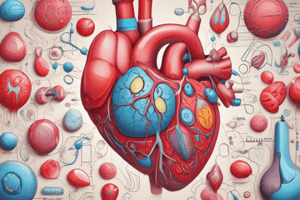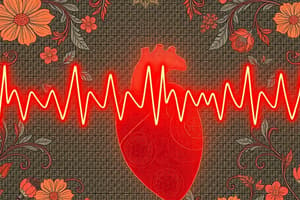Podcast
Questions and Answers
What is the primary action of venodilation on the heart?
What is the primary action of venodilation on the heart?
- Reduces heart filling and oxygen demand (correct)
- Enhances coronary blood flow
- Increases work of the heart
- Increases preload and heart workload
Which of the following conditions is associated with an increased risk of thrombus formation?
Which of the following conditions is associated with an increased risk of thrombus formation?
- Chronic asthma
- Atrial fibrillation (correct)
- Hypertension
- Hyperlipidemia
What is the primary action of dobutamine in the treatment of heart conditions?
What is the primary action of dobutamine in the treatment of heart conditions?
- Acts on α1 receptors
- Acts on β1 receptors (correct)
- Acts on β2 receptors
- Acts on angiotensin receptors
What is the role of anticoagulants like heparin?
What is the role of anticoagulants like heparin?
Which anti-thrombotic drug is used for long-term treatment and antagonizes vitamin K?
Which anti-thrombotic drug is used for long-term treatment and antagonizes vitamin K?
Which of the following is a key benefit of using ACE inhibitors in heart failure treatment?
Which of the following is a key benefit of using ACE inhibitors in heart failure treatment?
What mechanism do organic nitrates use to relieve angina symptoms?
What mechanism do organic nitrates use to relieve angina symptoms?
How do organic nitrates affect blood flow to ischaemic areas?
How do organic nitrates affect blood flow to ischaemic areas?
What is one of the effects of angiotensin II in heart failure management?
What is one of the effects of angiotensin II in heart failure management?
Which drug is typically administered intravenously for acute anticoagulant action?
Which drug is typically administered intravenously for acute anticoagulant action?
What effect does venodilation have on the oxygen demand of the heart?
What effect does venodilation have on the oxygen demand of the heart?
Which type of drugs reduces the preload of the heart as part of heart failure treatment?
Which type of drugs reduces the preload of the heart as part of heart failure treatment?
Which class of drugs is NOT typically used to treat angina?
Which class of drugs is NOT typically used to treat angina?
What is one of the secondary actions of organic nitrates on coronary arteries?
What is one of the secondary actions of organic nitrates on coronary arteries?
How do calcium channel antagonists help alleviate angina?
How do calcium channel antagonists help alleviate angina?
What effect does nitric oxide have on vascular smooth muscle cells?
What effect does nitric oxide have on vascular smooth muscle cells?
Which type of drug is most likely used to treat bradycardia or slow heart rates?
Which type of drug is most likely used to treat bradycardia or slow heart rates?
Which of the following best describes a re-entrant mechanism in arrhythmias?
Which of the following best describes a re-entrant mechanism in arrhythmias?
What is a potential cause of ventricular tachycardia?
What is a potential cause of ventricular tachycardia?
Which class of anti-arrhythmic drugs specifically targets voltage-sensitive sodium channels?
Which class of anti-arrhythmic drugs specifically targets voltage-sensitive sodium channels?
What is the likely effect of drugs that alter peripheral resistance in cardiovascular treatment?
What is the likely effect of drugs that alter peripheral resistance in cardiovascular treatment?
Which of the following is NOT a characteristic arrhythmia?
Which of the following is NOT a characteristic arrhythmia?
What is the primary consequence of abnormal depolarisations following an action potential?
What is the primary consequence of abnormal depolarisations following an action potential?
Which of these drugs would primarily affect coronary arteries blood flow?
Which of these drugs would primarily affect coronary arteries blood flow?
What effect do β-blockers have on the heart following a myocardial infarction?
What effect do β-blockers have on the heart following a myocardial infarction?
Which drug is an example of a class III anti-arrhythmic?
Which drug is an example of a class III anti-arrhythmic?
What is the primary mechanism by which lidocaine acts in the heart?
What is the primary mechanism by which lidocaine acts in the heart?
Which of the following best describes the term inotropic drug?
Which of the following best describes the term inotropic drug?
What is a common consequence of using drugs that block potassium channels?
What is a common consequence of using drugs that block potassium channels?
Which effect does verapamil have on the heart?
Which effect does verapamil have on the heart?
Why is adenosine considered an anti-arrhythmic agent?
Why is adenosine considered an anti-arrhythmic agent?
What distinguishes class IV anti-arrhythmic drugs from other classes?
What distinguishes class IV anti-arrhythmic drugs from other classes?
What role does lidocaine serve during a myocardial infarction?
What role does lidocaine serve during a myocardial infarction?
In what scenario is amiodarone particularly useful?
In what scenario is amiodarone particularly useful?
What is the primary purpose of negatively inotropic drugs in the treatment of heart conditions?
What is the primary purpose of negatively inotropic drugs in the treatment of heart conditions?
Which of the following is an example of a positive inotropic drug?
Which of the following is an example of a positive inotropic drug?
Which primary feature characterizes heart failure?
Which primary feature characterizes heart failure?
What effect do cardiac glycosides have on intracellular sodium levels?
What effect do cardiac glycosides have on intracellular sodium levels?
What is a potential side effect of cardiac glycosides on heart rate?
What is a potential side effect of cardiac glycosides on heart rate?
How do β-adrenoreceptor agonists primarily affect myocardial contractility?
How do β-adrenoreceptor agonists primarily affect myocardial contractility?
Which process does Na+/K+ ATPase inhibition lead to when affected by cardiac glycosides?
Which process does Na+/K+ ATPase inhibition lead to when affected by cardiac glycosides?
What role do positive inotropic drugs play in heart failure treatment?
What role do positive inotropic drugs play in heart failure treatment?
Which of the following statements is true about the action of cardiac glycosides?
Which of the following statements is true about the action of cardiac glycosides?
What do negatively inotropic drugs ultimately aim to reduce in heart failure patients?
What do negatively inotropic drugs ultimately aim to reduce in heart failure patients?
Flashcards
How does venodilation decrease heart workload?
How does venodilation decrease heart workload?
Venodilation, specifically widening of blood vessels in the venous system, directly reduces the amount of blood returning to the heart. This reduction in preload decreases the workload on the heart, resulting in a lower force of contraction and, subsequently, lower oxygen demand.
How do organic nitrates improve oxygen delivery to the heart?
How do organic nitrates improve oxygen delivery to the heart?
Organic nitrates, a type of medication, improve oxygen delivery to the heart muscle by dilating collateral arteries. Collateral arteries are smaller, alternative pathways for blood flow, which get enlarged by nitrates, increasing blood flow to the heart muscle, particularly areas that are starved of oxygen.
What are some heart conditions linked to an increased risk of blood clots?
What are some heart conditions linked to an increased risk of blood clots?
Atrial fibrillation, acute myocardial infarction, and mechanical prosthetic heart valves are among the cardiac conditions that significantly increase the risk of blood clots forming.
Positive Inotropic Drug
Positive Inotropic Drug
Signup and view all the flashcards
Negative Inotropic Drug
Negative Inotropic Drug
Signup and view all the flashcards
Heart Failure
Heart Failure
Signup and view all the flashcards
Cardiac Glycoside
Cardiac Glycoside
Signup and view all the flashcards
Digoxin
Digoxin
Signup and view all the flashcards
Beta-Adrenergic Agonist
Beta-Adrenergic Agonist
Signup and view all the flashcards
Inotropic Effect
Inotropic Effect
Signup and view all the flashcards
Cardiac Output
Cardiac Output
Signup and view all the flashcards
Afterload
Afterload
Signup and view all the flashcards
Preload
Preload
Signup and view all the flashcards
What are arrhythmias?
What are arrhythmias?
Signup and view all the flashcards
What is Ectopic Pacemaker Activity?
What is Ectopic Pacemaker Activity?
Signup and view all the flashcards
What are After-depolarizations?
What are After-depolarizations?
Signup and view all the flashcards
What is a Re-entry Loop?
What is a Re-entry Loop?
Signup and view all the flashcards
What is Ventricular Tachycardia?
What is Ventricular Tachycardia?
Signup and view all the flashcards
What is Supraventricular Tachycardia (SVT)?
What is Supraventricular Tachycardia (SVT)?
Signup and view all the flashcards
What is Bradycardia?
What is Bradycardia?
Signup and view all the flashcards
What is Atrial Fibrillation?
What is Atrial Fibrillation?
Signup and view all the flashcards
β-Blockers
β-Blockers
Signup and view all the flashcards
Inotropic drugs
Inotropic drugs
Signup and view all the flashcards
Class I Antiarrhythmics
Class I Antiarrhythmics
Signup and view all the flashcards
Class III Antiarrhythmics
Class III Antiarrhythmics
Signup and view all the flashcards
Class IV Antiarrhythmics
Class IV Antiarrhythmics
Signup and view all the flashcards
Amiodarone
Amiodarone
Signup and view all the flashcards
Adenosine
Adenosine
Signup and view all the flashcards
Lidocaine
Lidocaine
Signup and view all the flashcards
Drugs that block K+ channels
Drugs that block K+ channels
Signup and view all the flashcards
Lidocaine's mechanism of action in damaged myocardium
Lidocaine's mechanism of action in damaged myocardium
Signup and view all the flashcards
Dobutamine Action
Dobutamine Action
Signup and view all the flashcards
ACE Inhibitors and Angiotensin II
ACE Inhibitors and Angiotensin II
Signup and view all the flashcards
Diuretics and Heart Workload
Diuretics and Heart Workload
Signup and view all the flashcards
Beta-Blockers and Angina
Beta-Blockers and Angina
Signup and view all the flashcards
Organic Nitrates and Nitric Oxide
Organic Nitrates and Nitric Oxide
Signup and view all the flashcards
Angina Definition
Angina Definition
Signup and view all the flashcards
Calcium Channel Antagonists and Heart Workload
Calcium Channel Antagonists and Heart Workload
Signup and view all the flashcards
Organic Nitrate Examples
Organic Nitrate Examples
Signup and view all the flashcards
Study Notes
Action of Drugs on the Cardiovascular System
- Cardiovascular drugs treat various conditions, including arrhythmias, heart failure, blood clotting disorders, ischemic heart diseases, and hypertension.
- Drugs can modify heart rate, rhythm, myocardial contractility, peripheral resistance, blood volume, and coronary artery blood flow.
- Some drugs can impact multiple cardiovascular functions.
Arrhythmias (Cardiac Rhythm Disturbances)
-
Arrhythmias, or dysrhythmias, are abnormalities in heart rate or rhythm.
-
Arrhythmias can result from various factors like:
- Ectopic pacemaker activity (abnormal electrical impulses).
- Damaged heart tissue (myocardial damage)
- Latent pacemaker regions activated by ischemia
- After-depolarizations (abnormal depolarizations following electrical signals).
- High intracellular calcium.
- Prolonged action potentials
- Conduction delays
- Abnormal excitation spread within the heart.
-
Examples of arrhythmias include tachycardia (fast heart rate), bradycardia (slow heart rate), atrial flutter, atrial fibrillation, and ventricular fibrillation.
-
Specific types of tachycardia mentioned include ventricular tachycardia and supraventricular tachycardia.
-
Re-entry mechanisms can lead to arrhythmias, where electrical impulses repeatedly circulate within the heart. This can stem from incomplete conduction damage in certain regions. Re-entry loops are potential arrhythmia-inducing patterns.
Anti-arrhythmic Drugs
-
Four main classes of anti-arrhythmic drugs affecting heart rate and rhythm:
- Drugs that block voltage-sensitive sodium channels (e.g., lidocaine)
- Beta-adrenergic receptor antagonists (e.g., propranolol, atenolol; β-blockers)
- Potassium channel blockers (e.g., amiodarone)
- Calcium channel blockers (e.g., verapamil)
-
Lidocaine usage: Often used after a myocardial infarction (MI) if the patient has signs of ventricular tachycardia (given intravenously). Lidocaine works by blocking sodium channels in certain regions. It prevents the depolarization of cells.
-
β-blockers and uses: Often used following MI due to increased sympathetic activity. These medications prevent cardiac arrhythmias and decrease oxygen demand, mitigating myocardial ischemia, therefore beneficial post-MI.
-
Amiodarone: A type III anti-arrhythmic drug that also impacts other aspects of the heart. It is used to treat tachycardia associated with Wolff-Parkinson-White syndrome (re-entry loop caused by abnormal electrical pathways).
-
Calcium channel blockers, e.g., verapamil: Slow down heart rate, decrease AV node conduction, and lower the force of contraction. Suitable in certain cases.
Inotropic Drugs
-
Inotropic drugs impact the heart's contractile strength.
-
Negative inotropes: Used to lower the workload of the heart, such as after a myocardial infarction. Examples include β-blockers, helping to decrease oxygen demand and limit further damage by minimizing the heart's work.
-
Positive inotropes: Increase the heart's strength, beneficial in cases of cardiogenic shock or severe, reversible heart failure following cardiac surgery. Examples include β-adrenergic agonists like dobutamine.
Heart Failure
-
Heart failure occurs when the heart cannot meet the body's demand for oxygen.
-
Key features include:
- Reduced force of contraction
- Decreased cardiac output
- Reduced tissue perfusion
- Edema/fluid retention
-
Drugs used to treat heart failure aim to:
- Strengthen the heart's contraction (positive inotropes) examples include cardiac glycosides, dopamine.
- Reduce the heart's workload (treating hypertension or high blood pressure)—reducing afterload and preload by utilizing ACE inhibitors or diuretics.
Cardiac Glycosides (e.g., Digoxin)
- Have been a long-term treatment for heart failure.
- Digoxin: The prototype of this class.
- Extracted from foxglove plants.
- Mechanism of action: Inhibiting the Na+/K+ ATPase pump (which normally moves Na+ out and K+ in) leads to increased intracellular Na+ and subsequently greater Ca2+ influx into the myocytes, thus increasing the contractility of heart muscle fibers and cardiac output.
Organic Nitrates
- Commonly used to alleviate angina symptoms.
- Nitrates relax vascular smooth muscle, improving coronary blood flow and relieving angina pain.
- Key action of Organic Nitrates: By reacting with sulphydryl groups, NO₂ forms NO. NO is a potent vasodilator, resulting in the relaxation of vascular smooth muscle, thus relieving pain. It also improves blood flow through collateral (secondary) arteries, leading to enhanced tissue oxygenation rather than only relying on main arteries.
Hypertension
- Associated with elevated blood volume from sodium and water retention in kidneys.
- Possible treatments include:
- Diuretics (reduce blood volume)
- ACE inhibitors (inhibit angiotensin II formation, reducing vasoconstriction and sodium retention)
- β-blockers (reduce heart rate; can decrease cardiac output.)
- Calcium channel blockers (dilate blood vessels)
- α₁-adrenoceptor antagonists (dilate blood vessels)
Angina (Myocardial Ischemia)
- Chest pain associated with reduced oxygen supply to the myocardium (heart muscle) due to coronary artery narrowing.
- Treatments for angina aim to:
- Reduce the heart's workload (beta-blockers, calcium channel blockers, organic nitrates).
- Improve blood supply (organic nitrates, and calcium channel blockers).
Anti-thrombotic Drugs
- Certain cardiovascular conditions increase thrombus formation risk (e.g., atrial fibrillation, acute myocardial infarction, mechanical heart valves).
- Anticoagulants (e.g., heparin, warfarin): Prevent blood clotting.
- Antiplatelet drugs (e.g., aspirin, dipyridamol, clopidogrel): Inhibit platelet aggregation, decreasing the formation of blood clots.
Studying That Suits You
Use AI to generate personalized quizzes and flashcards to suit your learning preferences.






